The Ultimate Guide to Agile Procurement


Gone are the days when traditional procurement processes sufficed in the face of rapid market changes.
Supplier searches dragging on for months, cumbersome approval processes, and rigid contracts no longer meet the demands of dynamic markets.
Luckily, agility found its way from project management and software development to procurement.
Grounded in flexibility, collaboration, and adaptability, agile methods empower procurement teams to quickly adapt to market shifts, cultivate stronger supplier relationships, and stay ahead in a rapidly evolving landscape.
And today, we will show you why.
We’ll compare agile procurement with traditional methods, uncover its core principles, and shed light on the essential technologies you need to embrace agility in your organization.
Let’s dive in.
We will begin by comparing two approaches to procurement: traditional and agile.
Traditional procurement is like following a strict recipe, step by step, where each step must be completed before moving on to the next.
This method involves lengthy processes, such as:
As you know, all these processes can be slow and inflexible, laden with documentation at each step, and they often lock you into long-term commitments with suppliers.
If this kind of procurement follows a set recipe, agile procurement is more like being a chef who tastes and adjusts as they cook.
Agile procurement, following agile methodology, breaks down the procurement process into shorter sprints to enhance speed, flexibility, and adaptability.
While the same steps are necessary as in traditional procurement, agile teams can shorten the processes and even execute some of them simultaneously to save both time and resources.
For that, they need to leverage automation tools, which we will go more in-depth on later on.
Consider supplier sourcing, for instance.
In traditional procurement, finding the right suppliers can take months by following manual workflows.
However, agile procurement, powered by AI and big data tools, can accomplish this task within days or even hours.
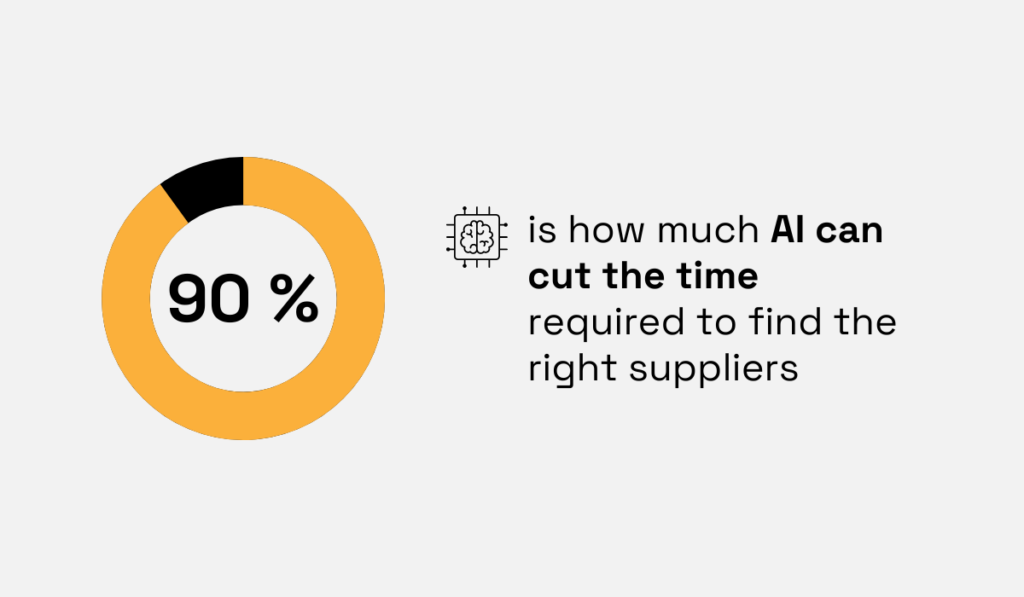
Illustration: Veridion / Data: McKinsey
Then, instead of manually sending out requests for proposals and waiting for vendors to respond, agile procurement will often bring potential suppliers to the table through workshops, sometimes even at the same time.
This way, organizations can quickly identify the right suppliers, understand their concerns, as well as negotiate and draft contracts on the spot.
In other words, traditional procurement processes, which usually last for months, can now be completed in a matter of days.
And with insights from the right team.
Namely, agile procurement teams consist of more than just procurement specialists.
In agile, it’s about assembling a cross-functional team that includes experts from legal, operations, finance, engineering, project management, as well as customers and suppliers.
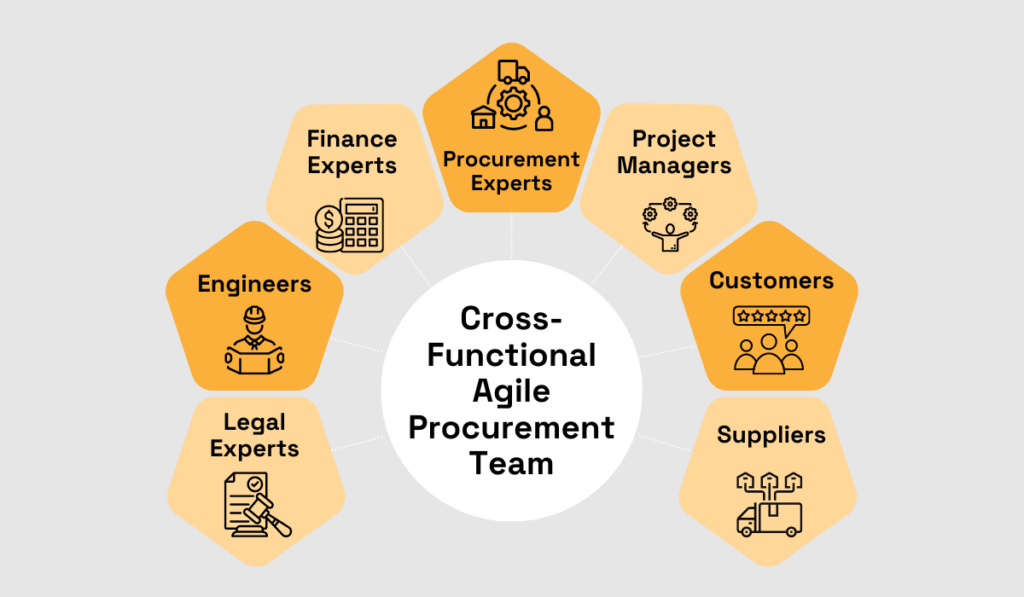
Source: Veridion
This collaborative approach to procurement fosters smoother, faster decision-making and ensures that all perspectives are considered before making decisions.
Another notable distinction between agile and traditional procurement is the focus.
Agile procurement prioritizes what’s most critical at the moment.
Mirko Kleiner, an expert and thought leader in Lean-Agile Procurement, offers a simple but powerful explanation in his session “Lean-Agile Procurement—Speed Dating for Businesses:”
“What is the most important thing you need first? Let’s invest maybe 1 million out of 100 or 10. We want to be so much faster on the market and test our hypothesis, and then if it’s worth it, we are going to (because it’s now so fast) continue the contract or find another supplier.”
In other words, instead of investing all resources upfront and locking organizations into long-term contracts, agile procurement allows for gradual investment.
This gives companies the power to quickly adapt to changing organizational needs, changing markets, and customer demands, or to simply find more suitable suppliers.
Below is a recap of the main differences between the traditional and agile approaches to procurement:
| Aspect | Traditional Procurement | Agile Procurement |
| Risk Management | Upfront planning | Iterative cycles for ongoing risk management and adaptation |
| Supplier Relationships | Transactional relationships based on predefined contracts and negotiations | Collaborative partnerships and ongoing communication |
| Cost Management | Bulk-purchasing and long-term contracts | Prioritizing value delivery and incremental investment |
| Project Scope Management | Fixed project scope | Embracing changing requirements and continuous refinement |
| Decision Making | Hierarchical decision-making structures with approval at multiple levels | Cross-functional teams make decisions collaboratively |
The entire premise of agile procurement is to speed up traditional lengthy procurement processes and be more flexible and adaptable when procuring products and services, and selecting suppliers.
This approach allows for quick adjustments based on real-time feedback, much like fine-tuning a recipe as you go.
Is the agile approach better than the traditional one?
Well—it depends on your project’s needs.
If you’re operating in a dynamic environment where speed and flexibility are crucial, agile procurement might be the preferred option.
However, if you have well-defined requirements and a fixed scope, traditional methods could still be suitable.
Ultimately, it’s about finding the right approach for your specific circumstances.
Just like in cooking—not everyone follows the same recipe.
By now, we explained that, instead of the traditional and rigid methods, agile procurement brings flexibility, speed, and continuous improvement to the table.
The real question is: how?
Through its 5 core principles, which we’re about to dive into.
In agile procurement, the goal is to speed up the journey from idea to value delivery.
In fact, agile procurement achieves this 4 to 8 times faster than traditional procurement, as Mirko Kleiner, an expert in the matter whom we mentioned earlier, explains.
So, instead of waiting for the entire procurement process to finish before seeing any benefits, you and other stakeholders can start experiencing value right from the start.
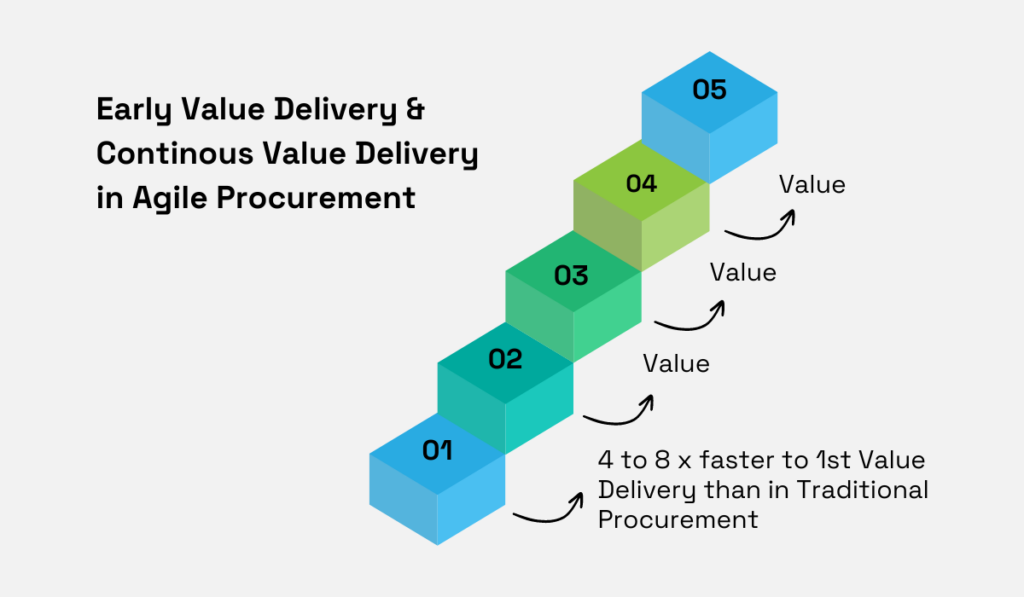
Illustration: Veridion / Data: Agile Insights by Agile Academy on YouTube
For instance, consider you are in charge of procuring software for a new project.
In traditional procurement, the process involves lengthy requirements gathering followed by waiting for the software to meet all specifications before implementation.
This can take months or even years—and it delays any value realization.
However, agile procurement accelerates this process.
Instead of waiting for completion, you prioritize essential software functionalities and procure them incrementally.
Through collaboration with internal stakeholders, your procurement team identifies core features necessary for the project’s initial phase.
Then, you procure a software solution capable of swiftly delivering these features.
As a result, stakeholders can start using the software and begin reaping benefits, even as additional features are developed and incorporated in the following iterations.
This approach ensures you receive value early on, fostering quicker returns on investment and increased satisfaction.
The second principle of agile procurement, adapting to change, underscores the flexibility and responsiveness inherent in this approach.
It’s about being prepared to pivot in response to unforeseen circumstances that may arise during your procurement journey—whether it’s a shift in your stakeholders’ needs, disruptions in your supply chain, changes in market demand, or new regulatory requirements.
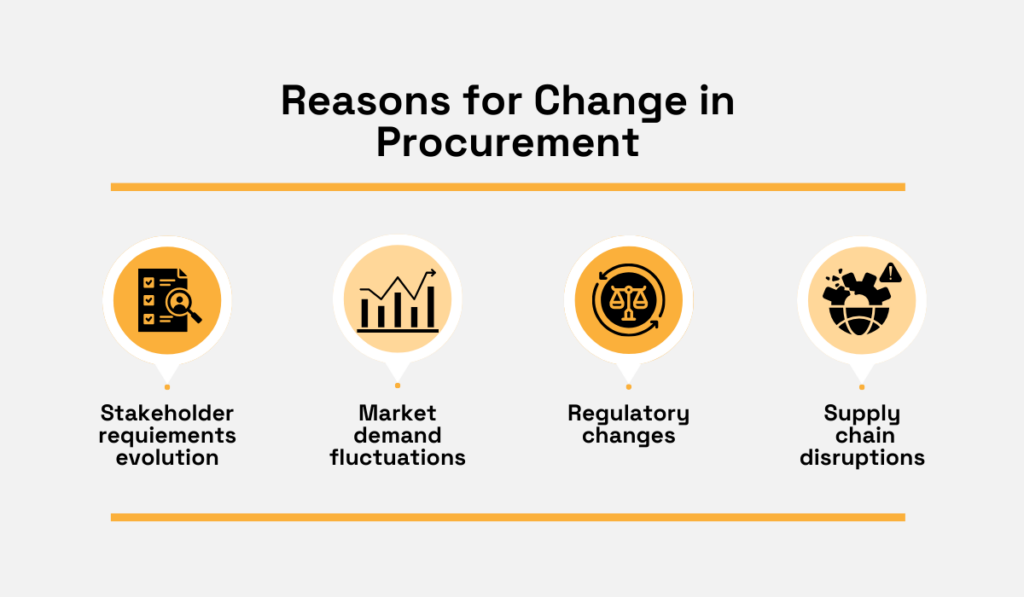
Source: Veridion
Imagine you’re in the midst of sourcing products from a supplier abroad when unexpected regulatory changes occur, affecting the importation process and potentially delaying your project timelines.
With agile procurement, you have the flexibility to quickly assess the situation and adjust your procurement strategy.
This might involve adapting contracts with your supplier to account for the new regulations, quickly finding alternative sourcing options, or speeding up delivery schedules to minimize disruptions.
By quickly adapting to these changes, you can ensure that your procurement initiatives stay on track and meet your organization’s goals.
That’s why, in agile procurement, contracts with suppliers are flexible enough to accommodate such changes.
And, of course, collaboration with suppliers should be strong and perpetual.
This is particularly crucial today as we witness supply chain disruptions and constant changes in demand and regulations.
In agile procurement, working on short cycles means breaking down your procurement process into smaller, manageable phases or sprints.
This enables faster progress, more frequent feedback (at the end of each sprint), and quicker adjustments to changing requirements.
One Quora user shared valuable insights into why they prefer this approach:

Source: Quora
And they can be easily applied to procurement.
Consider a scenario where a procurement team is tasked with sourcing a new supplier for raw materials.
By replacing the traditional way and adopting two-week sprints, the team can quickly engage with internal stakeholders to gather requirements and preferences.
They can then promptly reach out to potential suppliers, organize workshops with them, and solicit feedback, all in a short period of time.
Or let’s say a retail company needs to introduce a new product line to capitalize on emerging market trends.
Through agile procurement sprints, the team can speed up the sourcing of necessary components or merchandise.
By shortening supplier sourcing, negotiation, and contract finalization cycles, the company can bring new products to market faster and gain a competitive advantage over rivals.
Alternatively, imagine a construction project that requires specialized equipment to meet tight deadlines.
By working in two-week sprints, the procurement team can systematically evaluate equipment suppliers and test their reliability through short-term contracts.
Such an iterative approach mitigates the risk of committing to long-term agreements with ill-suited suppliers, allowing the team to adjust procurement strategies based on performance feedback.
However, working on short cycles is only feasible with the aid of procurement automation tools.
These tools streamline supplier sourcing, approval processes, and other procurement activities, eliminating manual workflows and enhancing efficiency.
We will delve into specific procurement automation tools ideal for agile procurement practices later today, so keep reading to learn more.
Another core principle of agile procurement is emphasizing lean sourcing.
This approach aims to streamline procurement processes and minimize waste, leading to enhanced efficiency and cost-effectiveness.
In simple terms, lean sourcing eliminates unnecessary steps and inefficiencies throughout the procurement process.
It optimizes research, sourcing, and negotiation with suppliers while reducing time, resource consumption, and documentation.
So, instead of laboriously reaching out to multiple suppliers, agile procurement leverages AI-powered platforms to analyze supplier data and recommend the best options based on specific requirements.
This reduces sourcing times and administrative overhead.
On top of that, Mirko Kleiner sheds light on another aspect of lean sourcing.
He reveals that vendors often inundate requests for proposals with unnecessary documentation, adding time and burden to procurement teams.
“Vendors usually add one page of deliverables and then 10 pages of assumptions of risks. We want to get rid of all these extra pages; we want to talk about all their concerns; we want to see how they react.”
The essence of lean sourcing, therefore, lies in cutting through this bureaucratic clutter to speed up the procurement process and transform supplier interactions.
Lean sourcing promotes direct, collaborative discussions over protracted proposal exchanges.
Procurement teams invite suppliers to dynamic workshops where concerns are addressed face-to-face, accelerating negotiation and fostering transparent relationships.
But lean isn’t just about supplier sourcing.
It extends to other procurement activities like raising purchase requests, generating purchase orders, and evaluating supplier performance.
By streamlining these operations, procurement teams can reduce workload, gain better visibility over procurement processes, and ensure they procure only what they need to avoid unnecessary spending or duplicate orders.
So, when you focus on lean sourcing in agile procurement, you prioritize efficiency, waste reduction, and strategic optimization to drive better outcomes for your organization.
Let’s go back to our recipe analogy once more today.
Continuous improvement is like refining a recipe—each time you cook, you tweak the ingredients to make it even better.
Similarly, in agile procurement, continuous improvement is about constantly fine-tuning your processes to deliver better results.
This commitment to improvement is ingrained in agile procurement because of its iterative nature.
After every sprint or phase, there is a time dedicated to retrospections and feedback from all stakeholders.
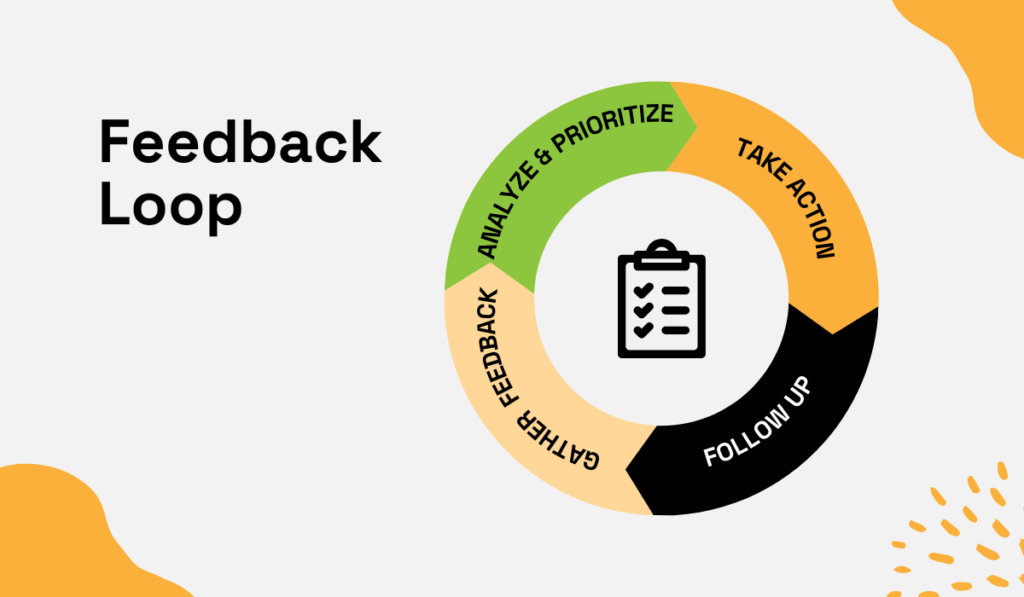
Source: Veridion
This feedback loop enables you to identify areas for enhancement and implement improvements to your procurement practices in real time, ensuring ongoing efficiency and effectiveness.
Whether it’s streamlining communication channels or refining evaluation criteria, incorporating feedback during the procurement process ensures that each procurement step becomes more successful than the last.
However, the journey towards agility and efficiency is impossible without technological innovations and real-time data.
Cloud-based procurement platforms, data analytics, and artificial intelligence support agile procurement principles, making procurement more flexible, adaptable, and responsive.
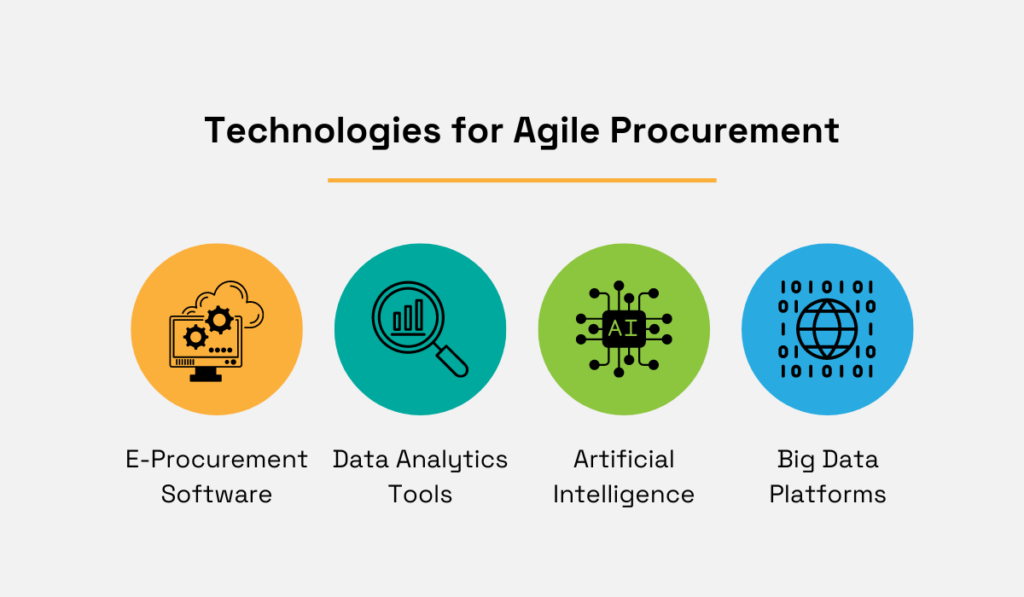
Source: Veridion
For example, central to modern procurement operations are cloud-based software solutions that provide a virtual hub for managing procurement activities seamlessly.
This includes automating approvals, generating purchase orders, and streamlining payments.
These platforms also offer a flexible, accessible solution that goes beyond geographical boundaries and enables all stakeholders to collaborate in real time.
At the heart of such tools is data.
By harnessing the data generated by procurement automation tools and leveraging other market intelligence, you can gain valuable insights into procurement performance, supplier behavior, and market trends.
For instance, advanced analytics tools transform historical procurement data into actionable intelligence, uncovering patterns, risks, and opportunities for improvement.
On the other hand, predictive analytics capabilities forecast demand, optimize inventory levels, and anticipate supply chain disruptions.
This empowers procurement teams to make proactive decisions and mitigate risks more effectively.
Finally, artificial intelligence (AI) technologies automate repetitive tasks, such as supplier research, data entry, and contract management, while natural language processing (NLP) algorithms extract insights from unstructured data sources, enabling you to derive value from diverse data sets.
All of these technologies work towards a shared goal: to make your procurement faster, with fewer errors, and more flexible when it comes to change.
Our supplier sourcing enabler, Veridion, is one such procurement technology.
Veridion is a big data platform that provides companies with data on millions of global suppliers and their products.
With Veridion’s search service and APIs, you can speed up supplier discovery by entering criteria and receiving a curated list of suppliers in no time.
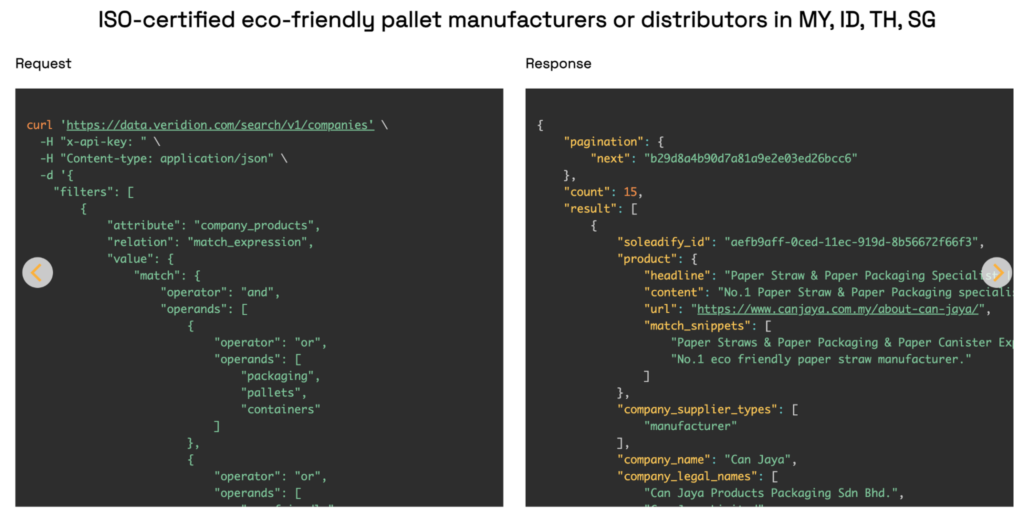
Source: Veridion
By slashing search times from months to days, Veridion shortens the lengthy traditional supplier search process.
On top of that, if there is a sudden demand to change suppliers because of supply chain risks or the suppliers don’t meet your demands anymore, you can quickly search for a better fit without starting the long supplier search.
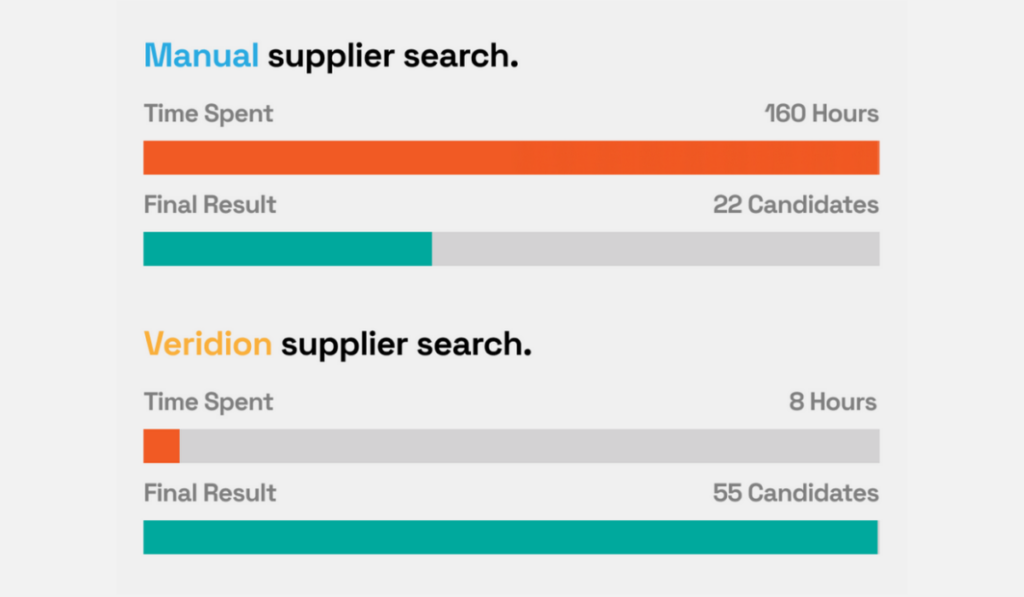
Source: Veridion
When you start embracing these technological advancements—procurement software, AI, and big data—you drive your procurement towards being more agile and efficient.
So, even if you have doubts about how the agile methodology, initially designed for software development, aligns with procurement, the answer lies in the adoption of these tools.
By integrating new technologies, you are already progressing towards enhanced agility in procurement processes.
The only thing left is a change in mindset towards agile thinking.
Agility is still widely associated with project management and software development.
However, nowadays, its importance in procurement is becoming increasingly evident.
With recent disruptions in the supply chain and constant fluctuations in the market, procurement teams like yours are under significant pressure to enhance resilience and agility.
Agile procurement offers a solution by breaking down processes into shorter phases, speeding them up, and leveraging innovative technologies such as cloud-based platforms, data analytics, and artificial intelligence.
With the help of these tools, you gain real-time visibility into your procurement, you are better equipped to mitigate risks and adapt to changes, and you can, ultimately, deliver greater (and early) value for your organization and all stakeholders.
Therefore, embracing agility in procurement is no longer an option—it’s essential, and it’s happening.